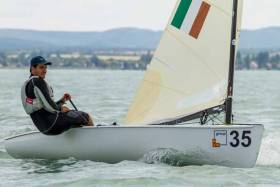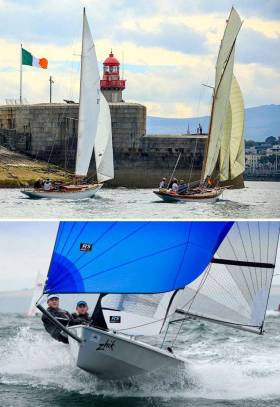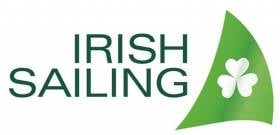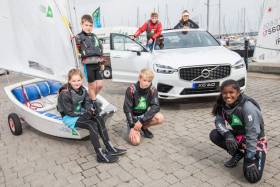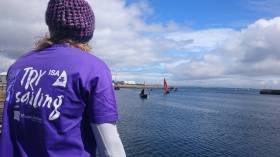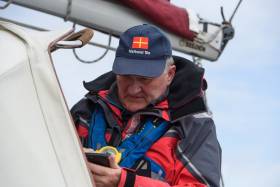Displaying items by tag: Irish Sailing
Irish Sailing Delegation for World Sailing Conference
Ireland has always played a role in the affairs of World Sailing, formerly ISAF, formerly IYRU. The peak of Irish representation was in the years from 1998 to 2004, when Dubliner Ken Ryan served as Vice President.
Today, the representation isn’t at such a high level, but Irish Sailing is involved in key World Sailing Committees and maintains its place on the World Sailing Council. While Irish Sailing has nominated most of those listed below, Commissions are appointed by the Board and some have been appointed by the International Class they are affiliated with. Currently listed as IRL on World Sailing Commissions and committees are:
Council Marcus Spillane
Sailor Classification Commission David Meagher, Donal McClement, Jamie Wilkinson
Equipment Committee Cathy MacAleavy
Equipment Rules sub-Committee Curly Morris
Events Committee
Match Racing sub-Committee Michael O’Connor
Oceanic and Offshore Committee Paddy Boyd
Race Officials Committee Bill O’Hara
International Umpires sub-Committee Bill O’Hara
Race Management sub-Committee Con Murphy
Racing Rules Committee Bill O’Hara
World Sailing Classes Committee Curly Morris (Equipment Rules rep)
The World Sailing Annual Conference takes place later this week in Puerto Vallarta, Mexico.
Attending World Sailing's Mexico Conference from Ireland is Bill O'Hara, Marcus Spillane, Paddy Boyd, Con Murphy and Cathy MacAleavey.
Much of the focus at World Sailing Conferences is on the equipment that is chosen for Olympic Games. While the 2020 Games will use the classes that were used in Rio, the battle is on for selection for Paris 2024.
 Bill O'Hara of Belfast Lough
Bill O'Hara of Belfast Lough
The final decision on this will not be taken until the 2018 Conference, but the debate is well under way, with the ”at risk” classes already lobbying to avoid the chop. World Sailing is seeking to align its Games strategy with the IOC’s Agenda 2020, so this November the discussion will be of a strategic nature considering the questions of gender equity (required by 2024), mixed classes, multi-medals (without increasing the quota) and evaluating new disciplines such as team racing, match racing and offshore events.
Four of the ten events will be reviewed in 2018, which four to be determined at the May 2018 meeting. The final decision on the events and the equipment used in those events will be made by the end of 2018, most likely at the 2018 November Conference. Currently, the men’s heavyweight event (Finn), is the only event not populated by both genders and as such will be under pressure.
The 470 is also coming under scrutiny as a dated class with one-design control issues, while the RS:X is also under threat as the equipment doesn’t enjoy popular appeal.
Removal of current events paves the way for consideration of an offshore two-handed mixed discipline, but the debate will also look at a more innovative approach, such as creating a team or match racing event amongst the athletes already selected, improving the medal count without increasing the total attendance.
Elsewhere on the agenda, amongst the usual governance issues, there are a couple of interesting proposals. One is to create a “Champion of Champions” event for World Champions in keelboat classes, similar in concept to Ireland's own 'All Irelands' competition.
In another initiative, the World Sailing Board is proposing to host an Offshore World Championships, two-handed, mixed gender in one-design boats. This is seen as a move to have IOC consider this discipline for future Olympic Games. it is most likely to be under review next year.
The World Sailing Annual Conference runs from November 4 to November 12, 2017.
2017 – A Very Irish Sailing Season
While sailing is now a year-round interest, and for many a year-round activity too, the notion of a traditional season is natural for anyone who lives in Ireland. Admittedly, there are times when we seem to be experiencing the four annual climatic seasons in just one day. But this sense of a seasonal change, and the appropriate alterations in activity which accompany it, are in our genetic makeup. And though marinas and the Autumn Leagues which they facilitate have pushed the season’s end back to the October Bank Holiday Weekend, for many, that’s it. It’s finally time for boats to be rested and energies deployed in other ways. W M Nixon reflects on highlights of the year.
These times we live in, they tend to emphasise big events – celebrity happenings you might call them – and our perceptions of a season past may be skewed by how the major fixtures played through. But your true Irish sailing season has at its core the classic club programme from April to October, with its plethora of weekend and weekday evening events. If you want to sense the beating heart of our sailing, you have to take the pulse of this local and club scene.
We know it’s not for everyone. Some dinghy crews only emerge for major regional and national championships. But week in, week out, it’s the regular local sailing, from the smallest club right up to the majestic programme of Dublin Bay Sailing Club, which sets the tone for the majority of sailors.
 Week in, week out, Dublin Bay Sailing Club provides a comprehensive programme of local racing from the end of April until the end of September, and it has been successfully doing so since 1884. Here the club's Beneteau 31.7s, one of DBSC's largest one design keelboat fleets negotiate a weather mark at the class championships Photo David O’Brien/Afloat
Week in, week out, Dublin Bay Sailing Club provides a comprehensive programme of local racing from the end of April until the end of September, and it has been successfully doing so since 1884. Here the club's Beneteau 31.7s, one of DBSC's largest one design keelboat fleets negotiate a weather mark at the class championships Photo David O’Brien/Afloat
And for those who sailed regularly all through the time-honoured season, it has to be admitted that weatherwise, we experienced a very mixed bag. As we shall see, there were brief periods of good weather which blessed some events. But in any case, one dyed-in-the-wool cub sailor firmly told us that as far as he was concerned, it was a very good season.
“For sure, there was rain and wind,” he said. “But we need wind for sailing. If you get a long period of rain-free weather, the evenings are likely to be wind-free as well. Frankly I’d rather get a good race in rain than sit becalmed on a perfect summer’s evening. But as we’re an east coast club, we often get that east coast effect of Atlantic weather without Atlantic rain, which is ideal for club racing. By and large, it has been a good sailing season, and race management seems to be improving all the time. So 2017 is going to go down as a good year for club sailing, but only a very average year for sunshine”.
As for Irish sailing’s national structure, inevitably there’s a clashing of events. There is only a finite number of weekends available at peak season when different big ticket regattas and championships hope to be staged, but as well, each club and area quite rightly expect to bring prestigious fleets to its part of Ireland.
However, in 2017 there was increasing emphasis at official club level on making sailing fun again. We’d begun to take it too seriously, something reinforced by the grim years of the recession, and then the winning in 2016 of Annalise Murphy’s Silver Medal at the Olympics in Rio.
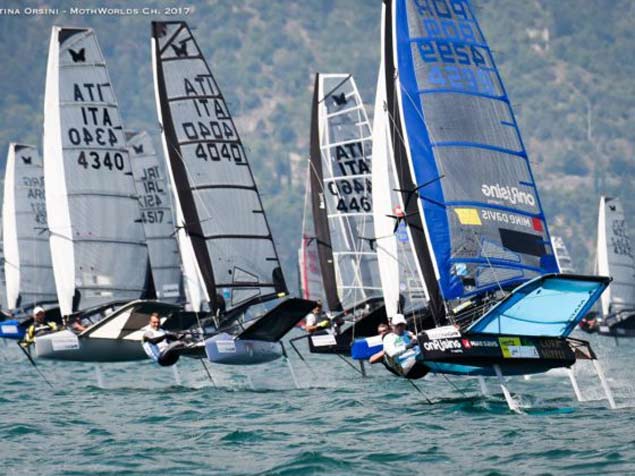 Olympic Silver Medallist Annalise Murphy led the way in signalling a change of mood for 2017 after the seriousness of her 2016 campaign towards success in Rio. In the early part of the season, she concentrated on the International Foiling Moth, and in this 223-strong fleet at the Worlds on Lake Garda in May, she became the Women’s World Champion. She is currently on a completely different direction for ten months on the Volvo Ocean Race as a crewmember on the One-Design Volvo Ocean 65 Turn the Tide on Plastic
Olympic Silver Medallist Annalise Murphy led the way in signalling a change of mood for 2017 after the seriousness of her 2016 campaign towards success in Rio. In the early part of the season, she concentrated on the International Foiling Moth, and in this 223-strong fleet at the Worlds on Lake Garda in May, she became the Women’s World Champion. She is currently on a completely different direction for ten months on the Volvo Ocean Race as a crewmember on the One-Design Volvo Ocean 65 Turn the Tide on Plastic
Of course the winning of Annalise’s medal was a matter for fun-filled celebration once it had happened, but the buildup to it was deadly serious, and that affected the tone of the national sailing mood in every area. But with the Medal in the bag, 2017 could reasonably expect to have a lighter mood, and this in turn helped us to adjust to an over-crowded programme, as crews could plan on a series of campaigns which balanced between serious events which provided proper championship results of national significance, and events which officially claimed to be providing everyone with a good time, even if some crews raced with deadly seriousness.
Either way, so much was going on that a review like this can only hope to give an impression of the season rather than a detailed analysis, but we’ll try to give it a comprehensible shape by listing the main events of Irish interest at home and abroad under either the “serious” or “fun” categorisations:
March/April: Intervarsity Championships – serious, UCD selected to represent Ireland
April: Irish Sailing Youth Pathway Nationals, Ballyholme - serious (and impressive), Ewan McMahon the star, Rush SC prominent in success
 The hyper-busy J/109 Mojito managed a hard-fought overall win in the ISORA Championship, successful participation in the Rolex Rastnet Race, and a second place in the Dun Laoghaire to Dingle Race.
The hyper-busy J/109 Mojito managed a hard-fought overall win in the ISORA Championship, successful participation in the Rolex Rastnet Race, and a second place in the Dun Laoghaire to Dingle Race.
April: Season-long ISORA Championship get under way, several venues – inevitably serious. In due course, J/109 Mojito (Peter Dunlop & Vicky Cox, Pwllheli SC) has very close overall win – despite taking time out to do the Fastnet
May: Scottish Series at Tarbert– serious, Pat Kelly’s J/109 Storm and Stephen Quinn’s J/97 Lambay Rules top their classes.
June: Howth Lambay Weekend – Fun
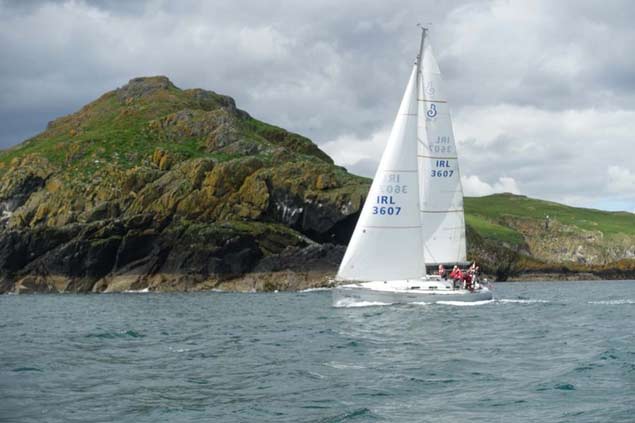 It could be a remote part of the West Coast, but Howth Yacht Club’s annual Lambay Race is a reminder that Ireland’s least-spoilt coastline is on an East Coast island. Photo courtesy HYC
It could be a remote part of the West Coast, but Howth Yacht Club’s annual Lambay Race is a reminder that Ireland’s least-spoilt coastline is on an East Coast island. Photo courtesy HYC
June: ICRA Nationals Royal Cork – probably the most serious of them all. John Maybury’s J/109 Joker 2 RIYC), Ross MacDonald’s X332 Equinox (HYC), and Paul Gibbons’ Anchor Challenge (RCYC) win the three main classes.
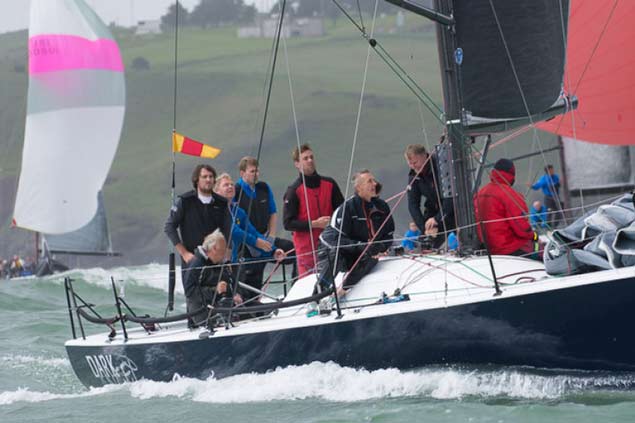 Rob O’Leary racing the Dubois 36 Dark Angel from South Wales to class success in the ICRA Nats at Crosshaven. Photo: Robert Bateman
Rob O’Leary racing the Dubois 36 Dark Angel from South Wales to class success in the ICRA Nats at Crosshaven. Photo: Robert Bateman
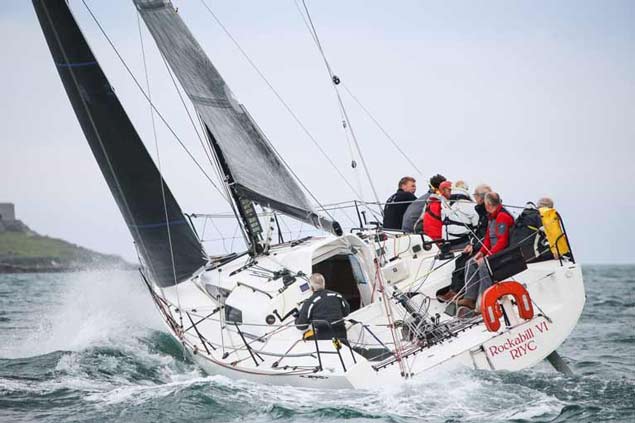 Paul O’Higgins’ JPK 10.80 Rockabill VI shortly after the start of the very tough Dun Laoghaire to Dingle Race, which she won, while a sister-ship Bogatyr was also winner of the likewise rough 608-mile Rolex Middle Sea Race in late October. This photo goes some way to revealing the reason for the JPK 10.80’s success – she is only 35ft LOA, yet you’d think you’re looking at a significantly larger boat. Photo: David O’Brien/Afloat.ie
Paul O’Higgins’ JPK 10.80 Rockabill VI shortly after the start of the very tough Dun Laoghaire to Dingle Race, which she won, while a sister-ship Bogatyr was also winner of the likewise rough 608-mile Rolex Middle Sea Race in late October. This photo goes some way to revealing the reason for the JPK 10.80’s success – she is only 35ft LOA, yet you’d think you’re looking at a significantly larger boat. Photo: David O’Brien/Afloat.ie
June: National YC Volvo Dun Laoghaire to Dingle Race – serious
June: Sovereign’s Cup at Kinsale – fun
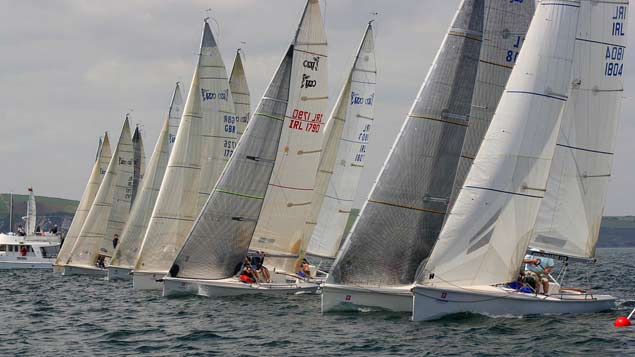 By maintaining its position as a standalone event, the Sovereign’s Cup at Kinsale can invite non-IRC classes to compete, and the 1720s responded with this keen turnout. The overall winner across all classes was adjudged to be Rob McConnell’s A35 Fool’s Gold from Dunmore East. Photo: Robert Bateman
By maintaining its position as a standalone event, the Sovereign’s Cup at Kinsale can invite non-IRC classes to compete, and the 1720s responded with this keen turnout. The overall winner across all classes was adjudged to be Rob McConnell’s A35 Fool’s Gold from Dunmore East. Photo: Robert Bateman
June: Dinghyfest at Royal Cork – brilliantly balanced mixture of serious & fun
July: Volvo Dun Laoghaire Regatta – superb, and fun
July: WIORA Championship at Aran Islands – unique
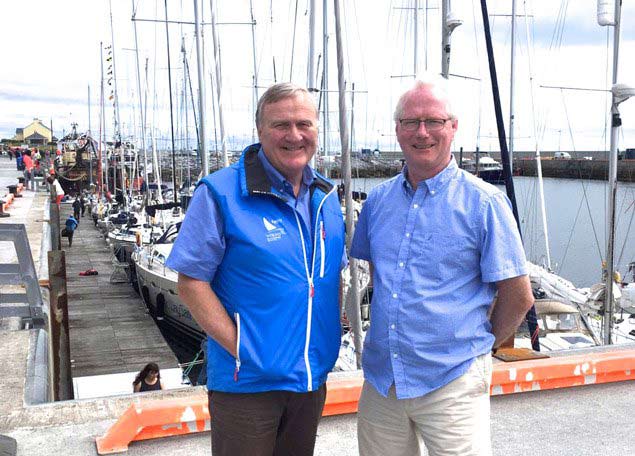 WIORA Nationals 2017 – and first time at the Aran Islands. Irish Sailing President Jack Roy (left) with WIORA organiser Cormac Mac Donncha. The popular Irish Sailing President seemed to have several doppelgangers, as that same evening he was present at the Opening Ceremony for the Volvo Dun Laoghaire Regatta, in which he also served for the entire four days as a Race Officer.
WIORA Nationals 2017 – and first time at the Aran Islands. Irish Sailing President Jack Roy (left) with WIORA organiser Cormac Mac Donncha. The popular Irish Sailing President seemed to have several doppelgangers, as that same evening he was present at the Opening Ceremony for the Volvo Dun Laoghaire Regatta, in which he also served for the entire four days as a Race Officer.
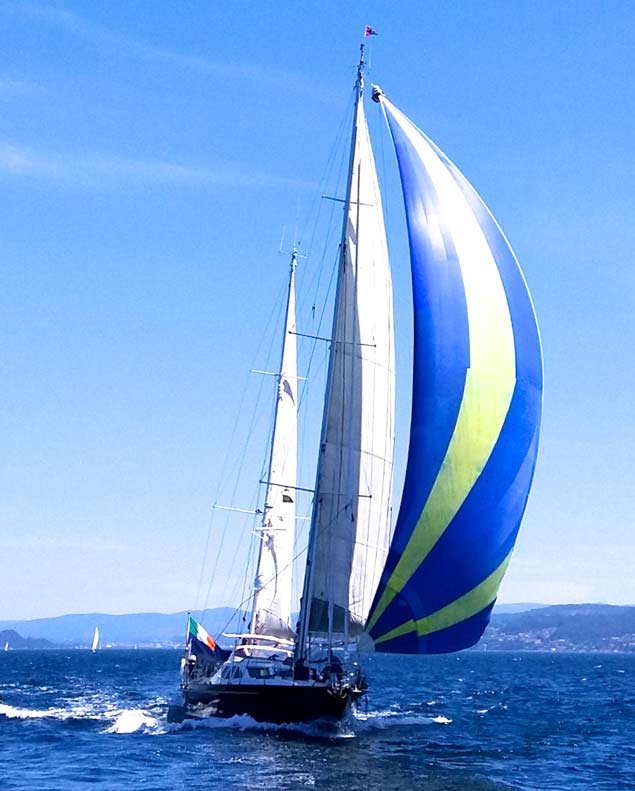 With more than sixty boats taking part, the Irish Cruising Club Rally in Northwest Spain was an outstanding success. This is Michael Holland’s 70ft 1993-built Dubois ketch Celtic Spirit – a veteran of Arctic and Antarctic cruising - making knots down the coast of Galicia. Photo: Trish Phelan
With more than sixty boats taking part, the Irish Cruising Club Rally in Northwest Spain was an outstanding success. This is Michael Holland’s 70ft 1993-built Dubois ketch Celtic Spirit – a veteran of Arctic and Antarctic cruising - making knots down the coast of Galicia. Photo: Trish Phelan
July: Irish Cruising Club Rally in Northwest Spain – seriously well organised, great fun to take part
July: Glandore Classics – fun, yet serious too
August: Rolex Fastnet Race from Cowes – serious
 Fastnet Rock astern for Jedi, the Irish National Sailing School’s successful J/109, which won class IRC 3B in the Fastnet Race, and also the Roger Justice Trophy for the top-placed Sailing School boat. Jedi is one of the 15-plus class of hotly-raced J/109s in Dun Laoghaire, whose annual championship was won by the Kelly family’s Storm from Rush SC and Howth, while the most successful boat in other events was John Maybury’s Joker 2.
Fastnet Rock astern for Jedi, the Irish National Sailing School’s successful J/109, which won class IRC 3B in the Fastnet Race, and also the Roger Justice Trophy for the top-placed Sailing School boat. Jedi is one of the 15-plus class of hotly-raced J/109s in Dun Laoghaire, whose annual championship was won by the Kelly family’s Storm from Rush SC and Howth, while the most successful boat in other events was John Maybury’s Joker 2.
August: Calves Week from Schull – prides itself on being a neat balance between fun and “quite serious racing”, and succeeds in being so.
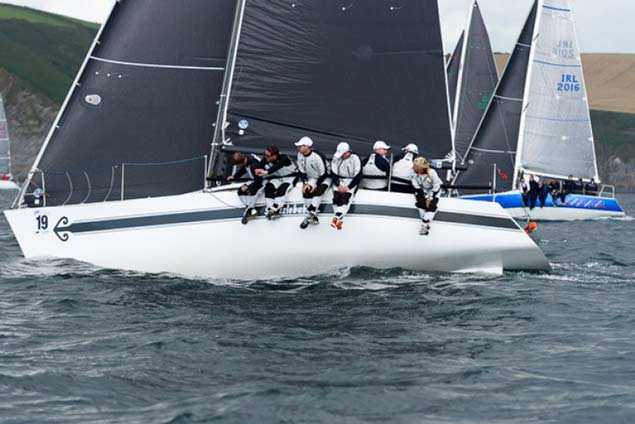 Everybody likes her, even if she beats them all. The characterful Swuzzlebubble racing to success in the Half Ton Classics at Kinsale. Photo: Robert Bateman
Everybody likes her, even if she beats them all. The characterful Swuzzlebubble racing to success in the Half Ton Classics at Kinsale. Photo: Robert Bateman
August: Half Ton World Classics at Kinsale: Supposedly serious, but in the ultimate lotus-eating venue and with such an extraordinary selection of boats, it couldn’t help but be fun. And everyone likes the slightly eccentric overall winner, the legendary Swuzzlebubble
August: Crinnui na mBad, Kinvara – traditional and fun
 The annual Crinnui na mBad at Kinvara in August may not have been favoured with good weather, but it was as popular as ever. This is one of the winners, John Flaherty’s Galway hooker Naomh Cailin, going out to race. Photo: Pierce Purcell
The annual Crinnui na mBad at Kinvara in August may not have been favoured with good weather, but it was as popular as ever. This is one of the winners, John Flaherty’s Galway hooker Naomh Cailin, going out to race. Photo: Pierce Purcell
August: Laser Nationals Royal Cork YC – serious
 RCYC Admiral John Roche, 2017 National Champion Finn Lynch (NYC) and Mark Whisker of sponsors Volvo at the prize-giving for the Volvo Laser Nationals at Crosshaven. Photo: Robert Bateman
RCYC Admiral John Roche, 2017 National Champion Finn Lynch (NYC) and Mark Whisker of sponsors Volvo at the prize-giving for the Volvo Laser Nationals at Crosshaven. Photo: Robert Bateman
September: Autumn League at Howth – fun event, but run with such serious efficiency that they’d a full programme completed after six weekends despite losing two days of racing to the late season’s poor weather.
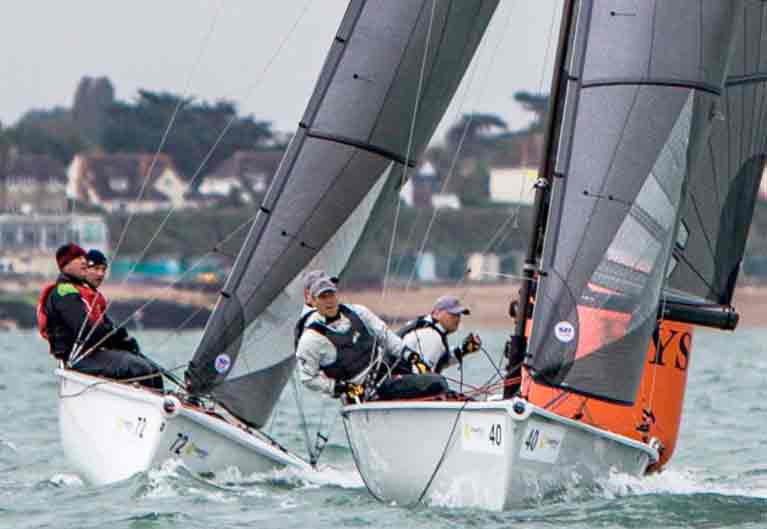 Royal St. George's Michael O'Connor, Davy Taylor and Ed Cook – SB20 'Corinthian' World Champions and Irish Champions
Royal St. George's Michael O'Connor, Davy Taylor and Ed Cook – SB20 'Corinthian' World Champions and Irish Champions
September: The SB 20 Nationals, incorporated into the first weekend of the Howth Autumn league as a three-day separate championship, had extra interest as it included recently-crowned SB 20 Corinthian World Champions Michael O’Connor, Davy Taylor and Edward Cook of Royal St George YC, who had won in the Worlds at Cowes. They added the Irish title to their 2017 trophy list.
October: Autumn League at Royal Cork - fun
October: Mini-Transat at La Rochelle – serious
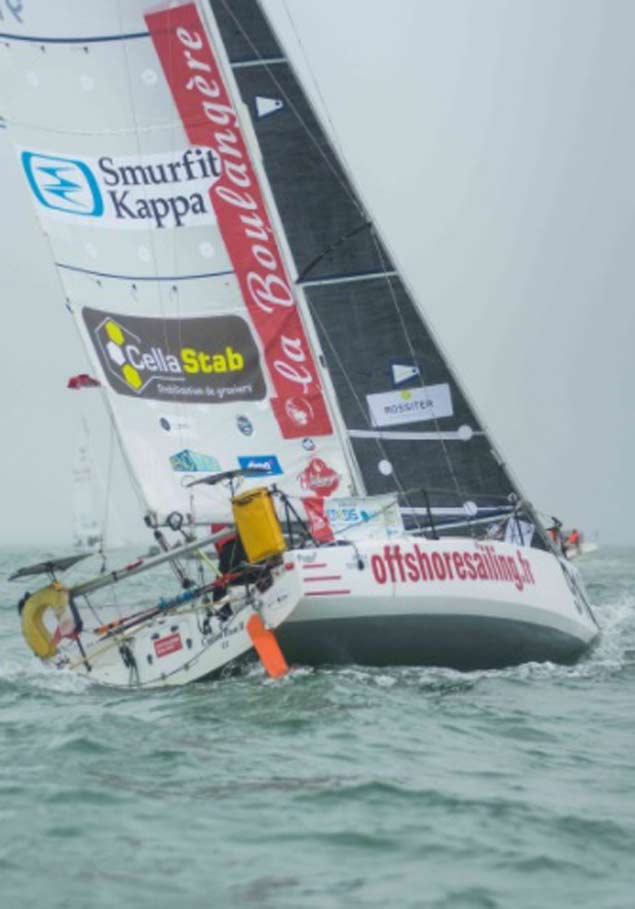 Ireland’s Tom Dolan in the first leg of the Mini-Transat 2017, 1,400 miles from La Rochelle to Las Palmas. He finished this stage 12th in a class of 55 boats The second Transatlantic stage starts on 1st November
Ireland’s Tom Dolan in the first leg of the Mini-Transat 2017, 1,400 miles from La Rochelle to Las Palmas. He finished this stage 12th in a class of 55 boats The second Transatlantic stage starts on 1st November
October: Junior All-Ireland at Schull – serious
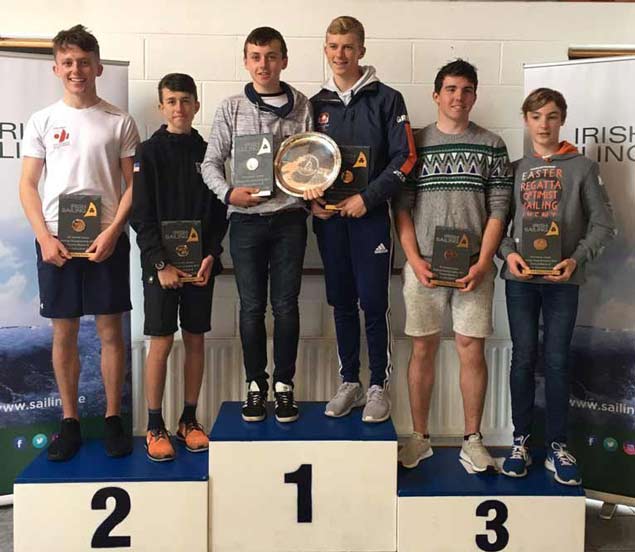 Junior All-Ireland winners on the podium. Kinsale YC’s champions Michael O'Suilleabhain and Michael Carroll, with second placed Rian Geraghty-McDonnell and Harry Durcan (RCYC) and Loghlen Rickard and Nathan Van Steenberge third. Photo: Robin Bateman
Junior All-Ireland winners on the podium. Kinsale YC’s champions Michael O'Suilleabhain and Michael Carroll, with second placed Rian Geraghty-McDonnell and Harry Durcan (RCYC) and Loghlen Rickard and Nathan Van Steenberge third. Photo: Robin Bateman
October: Senior All-Ireland Sailing Championship at Mullingar – serious and historic, as it is staged at one of the smallest, most rural clubs in the country, and raced in GP 14s.
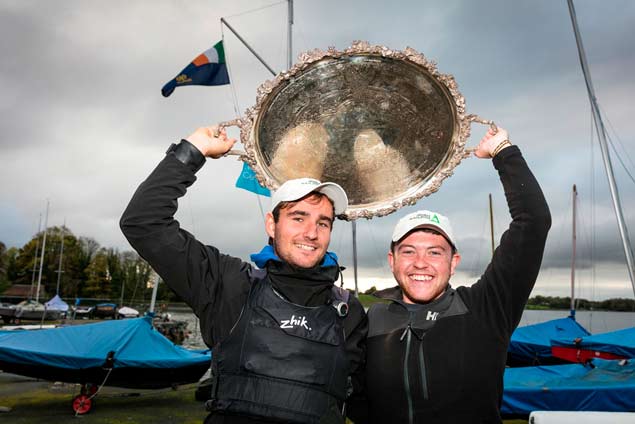 Fionn Lyden of Baltimore, All-Ireland Champion 2017, at Mullingar with the famous silver salver with crewmate Liam Manning of Schull. Photo: David Branigan/Sailing Ireland
Fionn Lyden of Baltimore, All-Ireland Champion 2017, at Mullingar with the famous silver salver with crewmate Liam Manning of Schull. Photo: David Branigan/Sailing Ireland
October: Student Yachting Worlds in Marseilles in France – serious. Ireland – a winner in times past –places fifth this time round.
October: Rolex Middle Sea Race from Malta – serious
October: Volvo Ocean Race from Alicante – serious
This fun/serious differentiation seems to have been supported by our wayward climate, which often managed to come up with good weather just when it was needed for the fun events, yet it achieved this in the midst of a generally very unsettled and often plain inclement summer.
The photos are all that is needed to show how this was so during 2017’s premier event, the Volvo Dun Laoghaire Regatta 2017 from July 6th to 9th. It wasn’t a sun-blasted regatta, but it wasn’t a wind-blasted one either – it was just a brief period of exceptionally pleasant warm weather with enough breeze for good racing , yet not too much wind to make it difficult to provide the in-harbour finishes which were introduced in special acknowledgement of the fact that they were also celebrating the Bicentenary of the massive work starting on the construction of this truly monumental and architecturally magnificent artificial port.
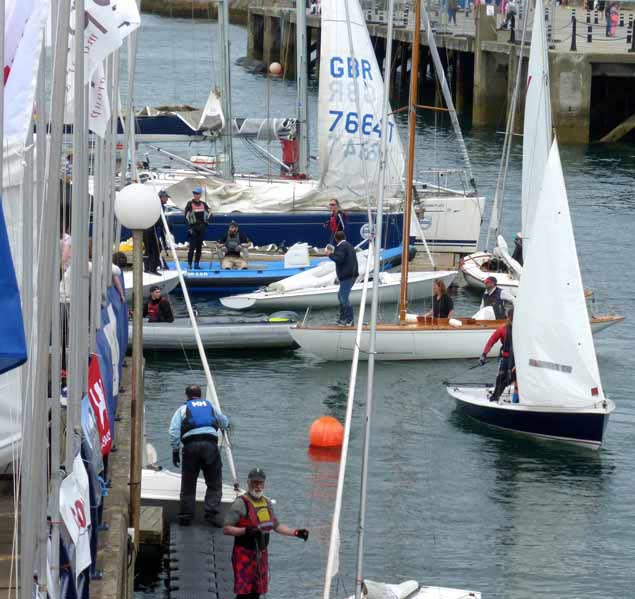 Piling them in – the good-humoured yet busy atmosphere off the National YC slipway after another day of racing in the Volvo Dun Laoghaire Regatta. Photo: W M Nixon
Piling them in – the good-humoured yet busy atmosphere off the National YC slipway after another day of racing in the Volvo Dun Laoghaire Regatta. Photo: W M Nixon
With 34 classes racing and boat numbers pushing towards the 500 mark, obviously it would have been totally inappropriate to try to include the ICRA Nats within it, as some have suggested. But even with such good conditions in its relaxed form, it could easily have got out of hand. However, with Organising Committee Chairman Tim Goodbody apparently yet always very quietly here, there and everywhere to ensure that all was running smoothly with a skillfully delegated team, it ran like clockwork to round out his two year stint in the top role with considerable style and success.
One noted visiting crew enthused that it was the best four days of sailing they’d ever had, and that was before they became aware that they’d won the ultimate trophy, the Kingstown 200 Cup, complete with a hundred guinea purse and a framed picture of the first regatta ever staged in what is now Dun Laoghaire, the Kingtown Regatta of 1828.
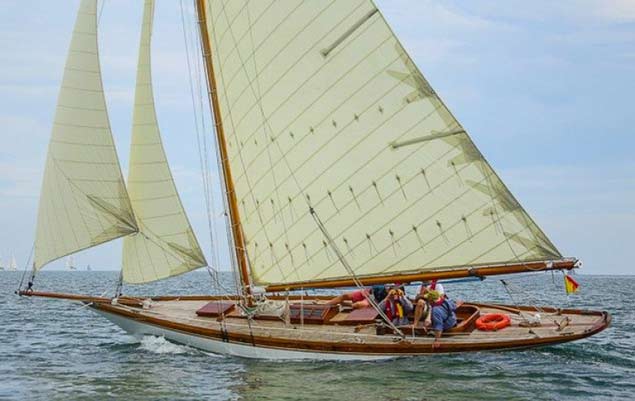 The sweetest boat in the fleet – Myfanwy from Wales - racing in the Volvo Dun Laoghaire Regatta. Photo: David O’Brien/Afloat.ie
The sweetest boat in the fleet – Myfanwy from Wales - racing in the Volvo Dun Laoghaire Regatta. Photo: David O’Brien/Afloat.ie
That was Rob Mason and his shipmates from Milford Haven with the classic 37ft Alexander Richardson-designed 1897-built gaff cutter Myfanwy, which Rob restored himself and sailed to Dun Laoghaire for the newly-introduced Classics Division, which was supposedly a one-off gesture to the Bicentenary.
But it worked so well that there’s talk of repeating it in 2019. Be that as it may, after the last race I was commiserating with the the Myfanwy team on their final placing, as I thought they’d sailed well enough to be comfortably on the podium, but Performance Echo decided others. Maybe they sailed too well. Yet far from being disappointed, they were on top of the world, and then when they went along to the huge prize-giving at the Royal St George, it was to hear to their complete surprise that the much-admired Myfanwy had been awarded the Kingstown 200 Cup and the prize purse and the historic picture……
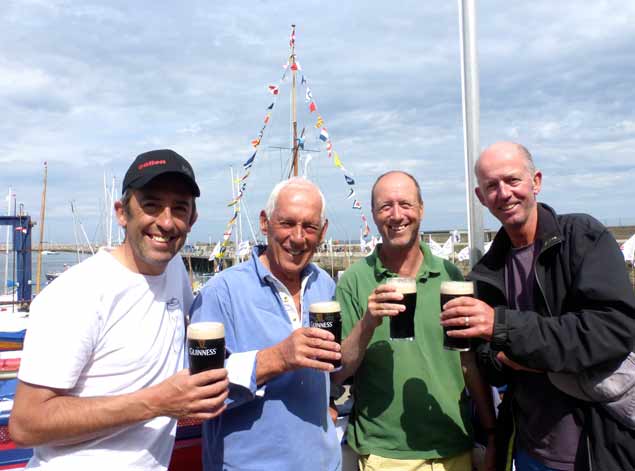 Before and after. Myfanwy’s crew celebrating “four days of the best sailing we’ve ever had” immediately after coming ashore at the conclusion of the final race in the Volvo Dun Laoghaire Regatta 2017. They are (left to right) Max Mason, his father Rob who restored Myfanwy, Andy Whitcher, and Gus Stott. The photo below shows them genuinely gobsmacked after finding they’d won the big trophy and its associated prizes. Photos W M Nixon and Gareth Craig/Fotosail
Before and after. Myfanwy’s crew celebrating “four days of the best sailing we’ve ever had” immediately after coming ashore at the conclusion of the final race in the Volvo Dun Laoghaire Regatta 2017. They are (left to right) Max Mason, his father Rob who restored Myfanwy, Andy Whitcher, and Gus Stott. The photo below shows them genuinely gobsmacked after finding they’d won the big trophy and its associated prizes. Photos W M Nixon and Gareth Craig/Fotosail

This classics success reflected a good year for the classic boats in Ireland, as six of the Howth Seventeens (1898) and a dozen of the Water Wags (1887 & 1900) made their way to the famous Sailing Week in the Morbihan in southern Brittany in May. Then at the end of July, the newest Howth 17s, Orla built in France for Ian Malcolm by the famous Skol ar Mor, arrived home, and in an epic effort in late August, in honour of Class President Hal Sisk, the continually reviving Water Wags managed their first turnout of more than thirty boats for their traditional Wednesday evening racing.
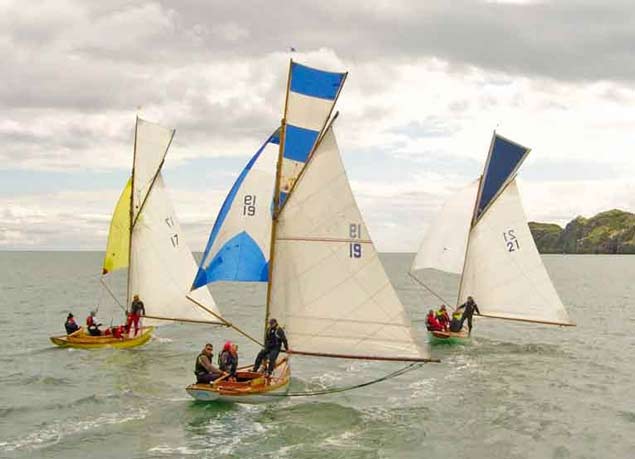 Howth Seventeens racing in their annual championship with Ireland’s Eye beyond – the new boat Orla (no 21) is on the right. Photo: Neil Murphy
Howth Seventeens racing in their annual championship with Ireland’s Eye beyond – the new boat Orla (no 21) is on the right. Photo: Neil Murphy
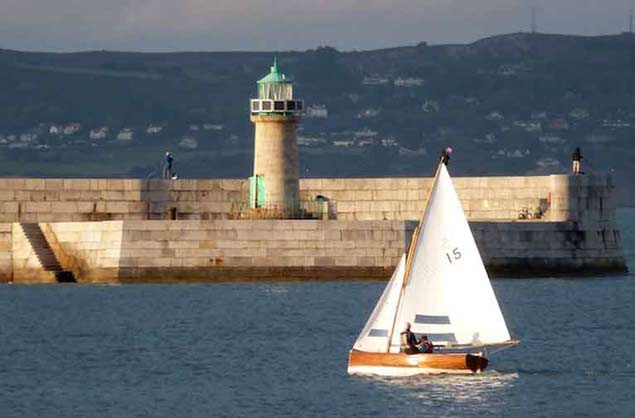 With a history going back to 1887, the Water Wags became an overnight success at the end of August when they finally managed a turnout of more than 30 boats. The clear winners were David & Sally MacFarlane with No 15 Mousmie, aged 107 years. Photo W M Nixon
With a history going back to 1887, the Water Wags became an overnight success at the end of August when they finally managed a turnout of more than 30 boats. The clear winners were David & Sally MacFarlane with No 15 Mousmie, aged 107 years. Photo W M Nixon
This has inevitably only been a skim across the events of 2017. An extraordinary season. Many hoped at the beginning of the year that it would see some relaxation after the intensity of the Olympic year, and while that may have been the overall mood, the achievements recorded above show that some sailors continued to take their own sailing very seriously indeed.
That is as it should be. But if I had to select a photo which captures the mood of 2017, the determination to make the best of it whatever the weather, then the Thomas Gautier image of Aoife Hopkins in devil-may-care mood, flying over a big sea off Douarnenez in Brittany on her way to winning the Laser Radial Under 21 European Championship, would undoubtedly be it. At that moment, Aoife was sailing for all of us.
 Sailing for all of us. Aoife Hopkins in devil-may-care style, on her way to winning the Laser Radial U-21 Euros at Douarnenez in July. Photo: Thomas Gautier
Sailing for all of us. Aoife Hopkins in devil-may-care style, on her way to winning the Laser Radial U-21 Euros at Douarnenez in July. Photo: Thomas Gautier
Irish Sailing Optimist Squad Investigation is Launched
An 'independent external' investigation into Saturday's Irish Sailing Optimist performance squad incident during Storm Brian at Dun Laoghaire is underway.
According to a statement on the association website last night, Irish Sailing President Jack Roy and CEO Harry Hermon have appointed Philip Scallan as independent external lead investigator. Scallan has already mapped out the areas of investigation to the President and requested additional time to investigate and consult with all parties.
It is understood a board meeting of the national governing body was held last night.
Roy commented: “Our priority is always the safety of our sailors and we are determined to establish all the facts relating to this incident. We look forward to receiving Mr Scallan’s report and implementing his recommendations so that we learn as much as we can from what happened and maintain the confidence of sailors and their families in our programmes”.
The statement says Scallan is a Safety Officer with many years of experience assessing and implementing safety standards in Irish and international sailing events. He will be assisted in this external investigation by Ger Keeling, a marine engineer and former CEO of the International Marine Rescue Federation who works with both Irish Water Safety and the RNLI.
According to the association, Scallan, who is based in the UK, will be travelling to Dun Laoghaire over the weekend and requests that any parent, sailor, witness, coach or any other party who feels that their contribution is relevant to the investigation, to get in contact with him promptly at [email protected].
Following a review of all the information received, and consultations with all the parties involved, Scallan and Keeling will also review Irish Sailing’s health and safety protocols before presenting their report which is expected to be finalised by mid-November and published.
Sailing Is A Powerful Tool To Mental Wellness
#Wellness - The therapeutic benefits of sailing have been highlighted by Social Entrepreneurs Ireland’s 2017 awardees Sailing into Wellness.
The Cork-based non-profit social initiative provides an opportunity for vulnerable groups to experience a completely new environment on the open sea.
For those with mental health issues, recovering from addiction or from disadvantaged backgrounds, sailing is proven to be a powerful tool in their development, say the organisers.
Working together as a team, individuals are supported to overcome personal challenges in an environment that is both exhilarating and therapeutic.
So help spread the word and bring a friend next time you are heading out for a potter in the bay.
If you’re interested in supporting Sailing into Wellness, contact [email protected]
Irish Sailing Performance ‘Volvo Junior Squad Programme’ Reactivated
Irish Sailing has announced the reactivation of the Irish Sailing Performance ‘Volvo Junior Squad Programme’, aimed at nurturing future talented Irish sailors.
The Irish Sailing Performance ‘Volvo Junior Squad Programme’ aims to develop and support talented young sailors, acording to a press release issued by the Irish Sailing Foundation.
It identifies and develops Irish junior sailors through training and coaching, introduces them to international racing, and prepares them for the next stages of their sailing career. The programme includes coaching and training on the water, but also on-shore workshops which look at sports psychology, fitness, nutrition, and physiotherapy.
Overseeing the Performance ‘Volvo Junior Squad Programme’ is Irish Sailing Academy Coach Ross Killian. The Junior squads are part of the Irish Sailing Performance Pathway which aims to nurture and develop sailors along a journey of six phases, leading ultimately to international regattas and Olympic level competition.
Three classes of boats will be included in the Performance ‘Volvo Junior Squad Programme’ – the Optimist, Topper and Laser 4.7 classes. Squad sizes will vary and will be selected through the programme’s application process.
Irish Sailing’s Jack Roy: A President for Our Times
The role of President of what is now Irish Sailing is central to our activities afloat. The diverse boating community that the President both serves and represents is affected by the variable socio–economic circumstances in which our sport - in its broadest sense – is functioning and developing. The way that the organisation lead by the President evolves to suit changing sailing and boating needs, the way that it caters for the requirements of ordinary sailors, and the level of international success achieved by our leading athletes - these factors affect us all.
Interwoven through every aspect of Irish Sailing and the diverse activities it caters for, the personality and abilities of the holder of the position of President play a key background role in our sailing and boating. They can significantly affect how we the participants see and experience what we do, and how the rest of the world perceives us. W M Nixon takes a look back to the roller-coaster of experience provided for Irish sailing in recent years, and tells us more about Jack Roy, the new President.
In the fallout years during and after the economic recession which began in 2008, what was then the Irish Sailing Association found itself in a complex and often conflicting situation. Shrinking consumer demand among ordinary sailors resulted in severe financial constraints, with painful cutbacks within the organisation and in the services it could provide to the wider sailing community. As for the customer base, most of them did their sailing through clubs which were themselves going through varying levels of trauma both in terms of declining active membership, and years of financial challenge.
Yet at the same time Ireland’s international sailors within the Olympic framework, and at other levels such as the Commodore’s Cup win captained by Anthony O’Leary in 2014, were showing great achievement and promise. This was to result in internationally-recognised success in 2016 when Annalise Murphy won the Silver Medal in the Laser Radial at the Rio Olympics. It was an achievement that significantly raised the mood nationally in an Ireland still struggling with the continuing effects of recession. And within sailing, it provided a boost of extra confidence in a sport which, despite an undoubted though arguably temporary shrinkage in numbers actively involved, had continued at its core level through the resilience of its truest adherents.
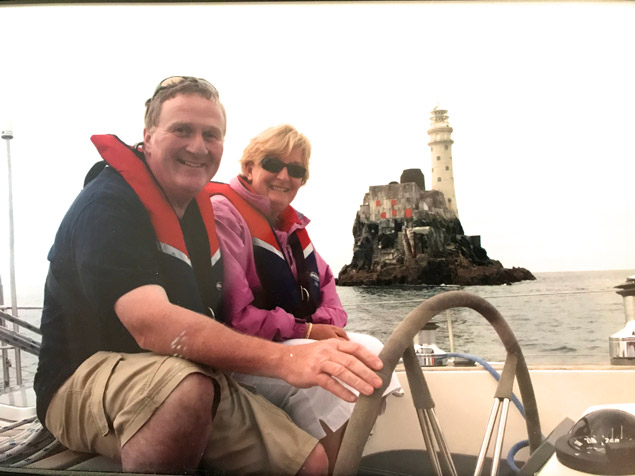 The relaxed helmsman. Jack Roy and his wife Rosemary on their Hallberg Rassy 46 Tangaroa at the Fastnet Rock during a West Cork cruise
The relaxed helmsman. Jack Roy and his wife Rosemary on their Hallberg Rassy 46 Tangaroa at the Fastnet Rock during a West Cork cruise
Inevitably the economic pressures had required some drastic cutbacks, and significant changes of direction in management. The Board of the Irish Sailing Association (ISA) decided that only by bringing in new blood could they ensure the necessary change of course, and in 2014 David Lovegrove became President for a three year period, despite not having been a Board member beforehand.
He brought a clear-eyed outsider’s view with exceptional experience both as a dinghy and keelboat sailor, as a former Commodore of Howth Yacht Club during its Centenary Year of 1995, and as an internationally-recognised Race Officer.
The very conscientious Lovegrove, a notably private person, was reckoned to be the safe pair of hands needed to guide the Association out of the wilderness. Much of this was done through quiet work behind the scenes, while the more public side of the ISA was represented by the High Performance division. In better economic times, the clubs and other boating organisations may be entitled to capital grants from governmental sports bodies. But in a period of financial stringency, the serious public money coming into sailing is basically aimed at Olympic success, for the truth is that Olympic sailing is the only branch of the sport to register at the required level of public interest.
Thus it was a difficult course the new President had to tread between introducing economy of expenditure – sometimes extreme economy – at most levels, while at the same time helping potential Olympic athletes make the best of what was available. For although it was in amounts much greater than any funding going to other areas of Irish sailing, it was almost absurdly small by comparison with major sailing nations.
It all came good in August 2016 with that marvellous medal win in Rio, while back home the green shoots of early recovery had long since developed into vigorous and broadly-based growth, even if some of those seriously damaged by the recession will never fully recover. But Irish sailing had come through, and in March this year David Lovegrove stood down as ISA President, and stood down as well from the Board to return to his core interests of club sailing and acting as a highly-regarded Race Officer at home and abroad.
Jack Roy, his successor as President until 2020, continues to bring to the job many of the qualifications and abilities David Lovegrove provided, yet the new President is a very different personality. Affable and outgoing, his exuberant and infectious enthusiasm informs everything he does, so much so that if he had a philosophy of life, it might be something on the lines if: “If you aren’t enjoying it, then why are you doing it?”
Admittedly if you went into David Lovegrove’s various interests, you’d find that in his very quiet way, he has much the same attitude. But while he was the ideal person to be President in the harsh recessionary times, Jack Roy is the ideal man at the helm when the going gets good.
It’s not that he hasn’t steered some organisations successfully through some very thin times, for he most definitely has. But somehow as the pace begins to pick up again, it seems right and proper that Jack Roy is holding the course.
So who is he, our new steersman? Well, he’s also a relative newcomer to the inner circles of the national sailing authority, as he was only brought onto the Board as recently as 2013, when the scale of the problems the ISA faced were becoming abundantly clearer by the day. The powers-that-be reckoned that as an active sailor, a fully accredited International Race Officer since 1998, an International Technical Officer (ITO) at the 2012 Olympics, and the instigator of many organisations and innovations in sailing, Jack Roy had the qualities they badly needed in Irish sailing’s national hours of need.
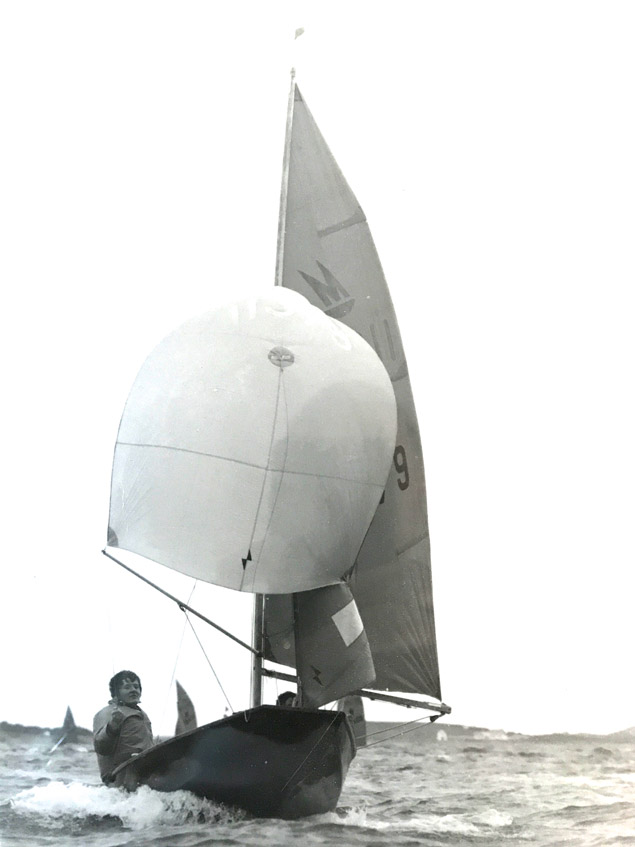 The first boat - the Mirror dinghy he built with his father in 1967 – means that this year, Jack Roy celebrates 50 years in sailing. The photo was taken at the Mirror Worlds in Sligo in 1973. Photo: John Fitzpatrick/courtesy Roy family
The first boat - the Mirror dinghy he built with his father in 1967 – means that this year, Jack Roy celebrates 50 years in sailing. The photo was taken at the Mirror Worlds in Sligo in 1973. Photo: John Fitzpatrick/courtesy Roy family
Having served four years on the Board, he has been President for nearly four months now. And a very busy four months they’ve been too, both for Irish sailing and the President, as he implements a policy of being personally present at as many major events as possible, while continuing his voluntary duties as a race officer with Dublin Bay SC every Thursday evening, and taking in the same task at several top events including the ICRA Nationals in Cork in June, and the recent Dun Laoghaire Regatta in Dublin Bay.
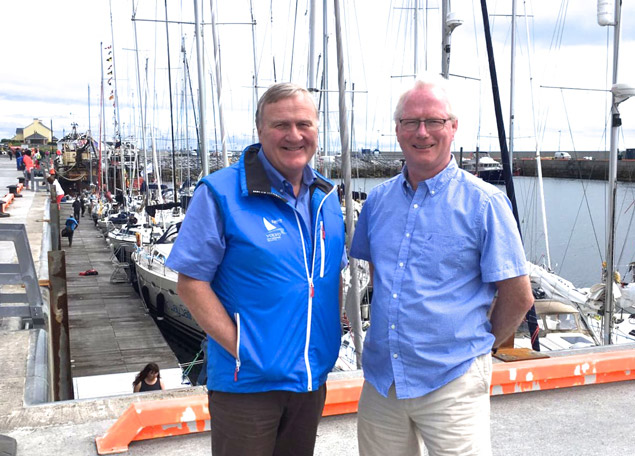 Jack Roy with event organizer Cormac Mac Donnacha at the first day of the WIORA Championship on the Aran Islands on Wednesday July 5th. That same evening, he was present at the Civic Reception in Dun Laoghaire Town Hall for the official opening of the four day Volvo Dun Laoghaire Regatta 2017. Racing in that started racing next day, and he served as one of the Race Officers throughout
Jack Roy with event organizer Cormac Mac Donnacha at the first day of the WIORA Championship on the Aran Islands on Wednesday July 5th. That same evening, he was present at the Civic Reception in Dun Laoghaire Town Hall for the official opening of the four day Volvo Dun Laoghaire Regatta 2017. Racing in that started racing next day, and he served as one of the Race Officers throughout
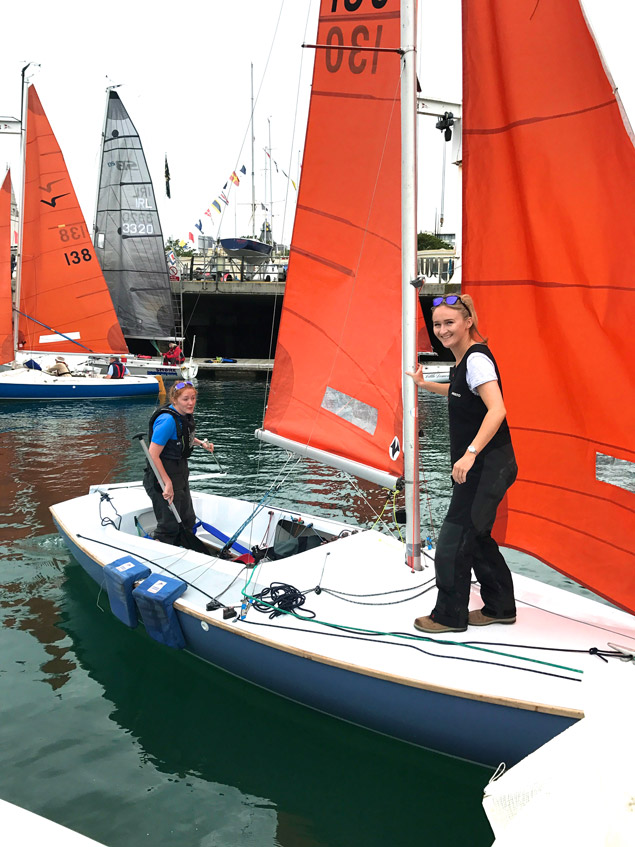 Jack Roy’s daughters Jill and Suzie taking the family Squib out to race in the Volvo Dun Laoghaire Regatta while their father was busy running one of the race areas
Jack Roy’s daughters Jill and Suzie taking the family Squib out to race in the Volvo Dun Laoghaire Regatta while their father was busy running one of the race areas
That mega-event marked a watershed in the 2017 season as the annual programme begins to shift its emphasis towards the late July and August schedules, so this week we managed to find a breathing space to get together in the cool peace of one of the Dun Laoghaire clubs in its pleasantly informal post-regatta mode, and Afloat.ie was given the opportunity to learn a bit more about Jack Roy.
Of course, just about every active sailor knows Jack Roy, in that he officiates at major events afloat, speaks passionately yet with wit and humour at many diverse functions ashore, and is himself a keen sailor aboard one of his two boats whenever he gets the opportunity. He exudes enthusiasm and energy so much you might call him a force of nature, and the story of his lifepath is one with which the entire Irish sailing community can readily identify, for all that he is a classic south County Dubliner through and through.
He’s a south Dub despite the fact that he was born in Greystones in 1958. His father – from Sandymount – had reputedly run away to sea as a boy, but in time the runaway became a leading figure in Dublin in the marketing and installation of lighting of all kinds to an industrial level. Yet the call of the sea was strong, so one of his sports was sailing, and among the craft he sailed aboard was Bonito of 1874 vintage, owned by Dun Laoghaire character Roy Starkey, and crewed by one Bob Geldof and his various relations.
An upshot of all this is that Jack Roy is a cousin of Bob Geldof Jnr. The precise details of who married whom and when and where is beyond the scope of this blog, but it’s all of a piece that Jack Roy is a cousin of Bob Geldof and is a true South Dub despite spending the early years of his boyhood in a seaside town in north County Wicklow.
While his father worked in the lighting business in Dublin and also established and ran a business in the same line in Manchester, he and Jack’s mother were very much involved in Greystones life, what with her involvement for many decades on behalf of the RNLI, and their shared interest in boats and the sea. They were both to become founder members of Greystone Sailing Club in 1968, and his father John was one of the leading figures in the late-1960s development of Greystones Harbour.
That all sounds like a much grander project than it really was. What happened was that the first attempt to use pioneering techniques to build a lighthouse for the Kish Bank off Dublin Bay in the 1960s ended in failure when the reinforced concrete structure cracked as it was being towed out to the Kish Bank from its building site in the Coal Harbour in Dun Laoghaire. The entire structure – including its large circular base – was condemned, but a second successful attempt to build the Kish Lighthouse was soon under way.
Meanwhile the maritime men of Greystones saw an opportunity to improve their tiny harbour at a stroke. They reckoned that the original soon-to-be-demolished base for the Kish Lighthouse would provide a ready-made basis for an enlarged breakwater at their home port, so they struck a deal, and a long slow tow brought the floating cast concrete base to its new home. It was moored up for the night to be ready for final placing and filling the following day, and then everyone adjourned to the Beach House for celebratory pints until a late hour.
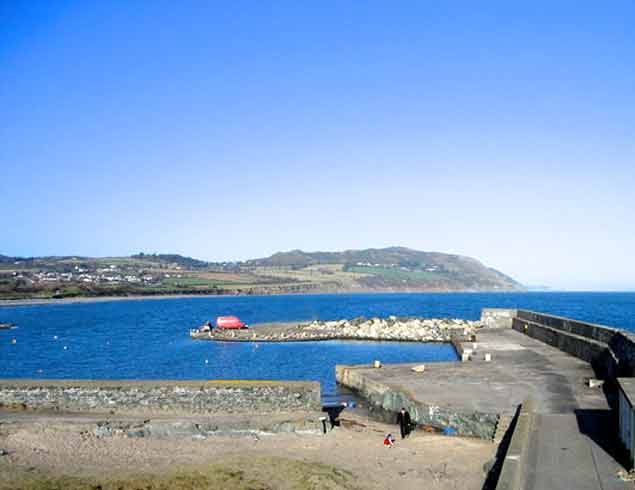 Greystones Harbour with its new breakwater as installed in the late 1960s. Jack Roy’s father John was one of those involved in acquiring the base of the experimental Kish Lighthouse for re-use as the main part of the breakwater. The former lighthouse base is under the red van in the photo
Greystones Harbour with its new breakwater as installed in the late 1960s. Jack Roy’s father John was one of those involved in acquiring the base of the experimental Kish Lighthouse for re-use as the main part of the breakwater. The former lighthouse base is under the red van in the photo
But when everyone looked out in the morning to admire yet again the basis for their new pier, there it was – gone. The ebb tide had taken it away. Fortunately, it had gone no further than South Beach, and they managed to get it back and set in place on a more permanent basis to be the basis of Greystones Harbour for many years. But with the much more recent new harbour work at Greystones, you’d need to be an archaeologist to find the old base of the first Kish Lighthouse, though it’s probably somewhere deep under the new Greystones Sailing Club building.
Back in 1967, the sailors of Greystones made the move into Mirror dinghies, and John Roy built one with his son’s help. Today, Jack Roy has only to get the whiff of fibreglass work under way to be transported on a wave of nostalgia back to the happy days when he and his dad were building his Mirror in the garage fifty years ago, which means he has become president of the Irish Sailing Association in the same year that he celebrates fifty years of being an active owner-skipper.
With an equally young Pearse Dunne as crew, Jack Roy campaigned the Mirror with growing expertise, but when Greystones Sailing Club – formed the year after the Roy family had built their Mirror – began to plan a move up into Enterprise dinghies which could also be home built, young Jack showed his distinct streak of individuality. While the Enterprise was an attractive boat, she didn’t have a spinnaker and she didn’t use a trapeze, and the 16-year-old Jack Roy wanted both, so in 1974 he threw in his lot with the developing International 420 Class in the National Yacht Club in Dun Laoghaire.
While Greystones still remains very special to him, by this time has life increasingly revolved around south Dublin, where he was a pupil at Blackrock College and then St. Gerards in Bray. He was drawn into the trophy-winning rugby team at Blackrock, displaying his talents as a loosehead prop in the thick of the scrum. It’s a character-building position, to say the least. And as Jack quips, it gives you a very thick neck, which is a very good thing to have if you’re going to give frequent service as a race officer in sailing.
It also reinforced his enthusiasm for team effort. He is at his best in a team in any role including captain, and in a sense this was reflected in his sailing, as he never became personally involved in the growing number of single-handed classes which were developing throughout Ireland.
His sailing nevertheless was proceeding apace, with a new 420 and international competition. But surely the most important thing to have happened to him is that in 1975 he met Rosemary Dobbyn. He was aged just 17. He was smitten. By the time he was 23, they were married. They continue to be so much together that they work together, and on his race officer duties, she is the timekeeper.
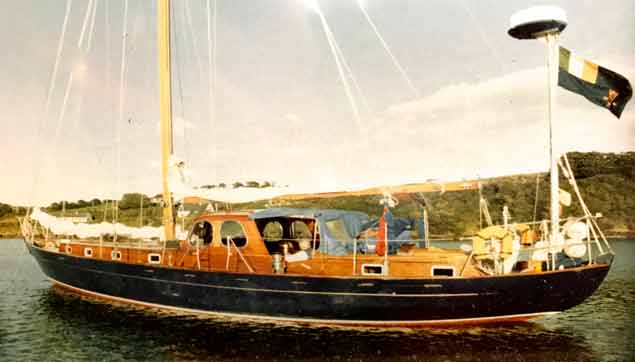 The Roy family’s William Garden-designed 52-footer Pegeen in Castletownshend, West Cork. Pegeen played a key role in family life from 1975 to 1989
The Roy family’s William Garden-designed 52-footer Pegeen in Castletownshend, West Cork. Pegeen played a key role in family life from 1975 to 1989
By this time his parents were expanding their own interests afloat, and there was much family cruising with a variety of craft, starting in 1972 with a Scottish-built 36ft Miller Fifer Motor-Sailer. But one day in Arklow they spotted a 52ft American sloop Pegeen newly in from a rough Atlantic crossing which had cured the owners’ enthusiasm for voyaging. Jack’s father was drawn to the boat and after length negotiations he finally secured her, and from 1975 to 1989, Pegeen was central to the Roy family life for all generations.
Designed by William Garden and teak-built in 1957 in China, Pegeen taught Jack much of what he knows about cruising, and she taught him almost more than he wants to know about maintaining a wooden boat. She also broadened his knowledge about Irish sailing locations – having cruised the places conveniently reached from Dublin Bay since 1975, from 1981 onwards the Roy family based Pegeen in East Ferry in Cork Harbour, commuting to her at weekends and making West Cork into their ideal of cruising perfection.
Yet at the same time young Jack’s racing career was developing in Dublin Bay and at international events, while he took the clearcut step of going straight from school into the family industrial lighting business, immediately showing a very strong work ethic. With the Irish construction industry being volatile, to say the least, the family’s Manchester business had a significant role to play, and for a while Jack and Rosemary lived and worked there.
But they decided Ireland was always to be their home, they settled in Loughlinstown southwest of Dun Laoghaire and are still in the same area, though in a different house. Jack immersed himself in the family’s Dublin business while Rosemary worked as a midwife in the National Maternity Hospital in Holles Street, rising through the front line ranks to register 22 years of service to Ireland’s population boom.
Jack and Rosemary Roy are both grafters, it’s central to what they are - it’s the way they approach things and they believe both in hard work and in enjoying it too. So somehow while developing and guiding the lighting business on Jack’s side and putting in long hours in Holles Street on Rosemary’s, they became a family with daughters Jill and Suzie, while Jack’s sailing – based now at the National Yacht Club – moved onto a new level with his devoted involvement with the Flying Fifteen class.
Not that all ties with family cruising were dropped, for although the increasingly-demanding Pegeen was sold in 1989, Jack’s parents promptly replaced her for another ten years of cruising with the Nicholson 38 ketch Conche, a much easier maintenance proposition with her fibreglass hull and more manageable size.
But since 1981 – after a brief flirtation with the International 470 – Jack Roy’s racing was with the Flying Fifteen class, and with crewman Mal Nowlan – who continues as a good friend and a member of his Race Management team – he was increasingly there or thereabouts at the front of the Flying Fifteen class.
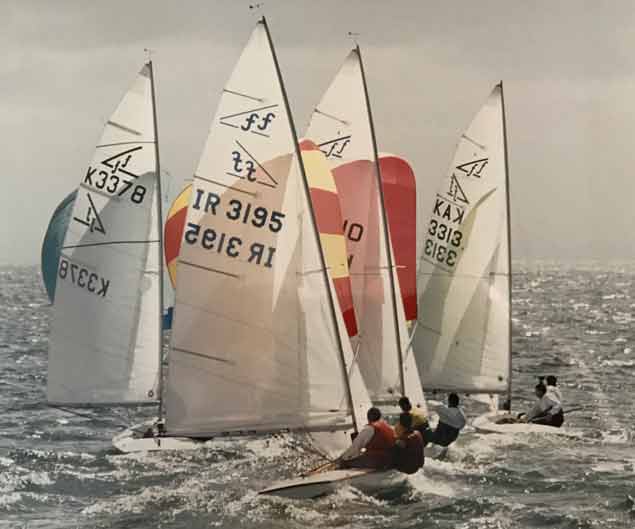 Jack Roy racing his Flying Fifteen Ffrisbee (3195) at the Worlds in Dublin Bay in 1992, crewed by newcomer Dave Gorman. They were getting places up to fourth
Jack Roy racing his Flying Fifteen Ffrisbee (3195) at the Worlds in Dublin Bay in 1992, crewed by newcomer Dave Gorman. They were getting places up to fourth
And he was being drawn into many aspects of sailing administration, by 1986 becoming Honorary Sailing Secretary of the National Yacht Club. One evening, it was discovered that the designated Race Officer was a no show, so Jack took on the job just for that evening’s racing. But he discovered he’d a taste and a talent for it, and particularly enjoyed finding it was a team effort rather than a one man band. A new strand had been added to his already busy sailing career and demanding working life.
At the same time, he was increasingly involved in the shoreside politics of sailing through the Flying Fifteens, finding that he much enjoyed the increased range of friendships which international events provided – he continues to have good friends in New Zealand as a result of the Flying Fifteen Worlds in Kinsale in 1984.
However, he was concerned with the way that the Flying Fifteen class in Ireland, now spread through the country but with its longest-established centres in the north, seemed increasingly to be reduced to being a subsidiary of the British class association, which he feared would limit the number of places available to Irish sailors at World Championships. So he patiently set about creating a new entity, the Flying Fifteen Association of Ireland, and after much quiet negotiation behind the scenes, he had the basics in place and needed one final piece of the jigsaw to make it complete.
To give it credibility in the north in what was still the depths of the Troubles, that final piece of the jigsaw which he had to find was a leading Northern Ireland Flying Fifteen sailor to take on the role of President, and in Jim Rogers of Kircubbin on Strangford Lough he found the ideal man to give backbone to an organisation which gave the class a new lease of life throughout the country.
This was to become evident at the highly successful International Fying Fifteen Worlds at the National Yacht Club in 1992, in which Jack was deeply involved both as a competitor and in the background organisation, though his regular crewman Mal Nowlan was even more deeply involved ashore, so Jack had to introduce a new crew, one Dave Gorman, who has since gone on to be Irish Flying Fifteen champion.
But by this stage even Jack Roy had to cut back on some aspects of his life as his work level in the growing family business – which he was to head up from 1995 onwards – increased with the growth in the Irish economy, and he and Rosemary were now proud parents of their two girls.
He knew he enjoyed the occasional sailing foray into other classes – he was to do two major campaigns in International J/24 racing with longtime sailing friend Roger Bannon – and his increased involvement with Race Management provided a measurable level of participation with a sport he loved, so in 1993 he sold out of the Flying Fifteen class and went boat-less for a whole four years. But being the man he is, his Race Officer duties were in the ascendant at home and abroad, and in 1998 the world sailing body – the International Sailing Federation since 1996 – officially accredited him as an International Race Officer.
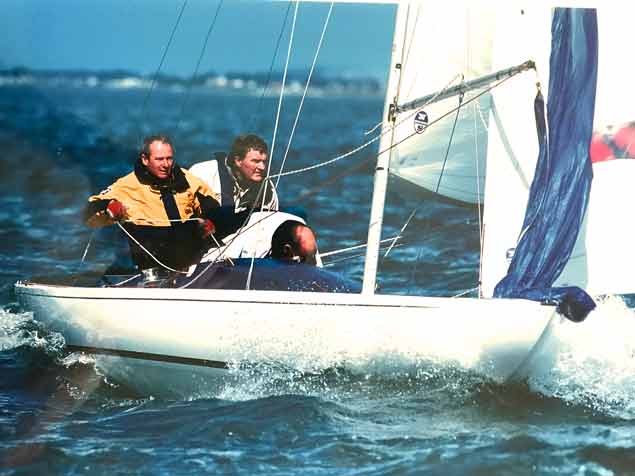 Declan Hayes, Jack Roy and Andrew Mackey in the thick of it, racing their International Dragon Sabbatical in 1998. Photo: Brendan Fogarty
Declan Hayes, Jack Roy and Andrew Mackey in the thick of it, racing their International Dragon Sabbatical in 1998. Photo: Brendan Fogarty
But by that time the call of boat ownership had again become too strong, and since 1997 he’d owned an International Dragon with Andrew Mackey. Quite how he combined his new international duties with co-ownership of a demanding boat in a hot class heaven only knows, but within a year he’d rationalized it by transferring his sailing base to the Royal Irish YC and moving into another Dragon still in partnership with Andrew Mackey, but with Declan Hayes added to the ownership team.
They kept this going for five years, which is good going in such a challenging class environment, and had a huge amount of sport at many venues. But by 2003 the work/life/sport balance had become so hectic that he again relinquished boat ownership, and gave all his sailing attention to Race Management while much of his energy ashore was taken up with the family business.
It was a time of crazy expansion in the Irish construction industry, and anyone providing the best quality industrial lighting installation and follow-up was on the crest of the wave. The family firm which Jack now headed was unbelievably busy, and Jack found himself entertaining an interest from his main Swedish suppliers to take a stake in the business.
He and Rosemary were consdering this when the offer came through from Sweden in 2007 of a complete takeover. This was something else altogether. This was the family firm, central to their sense of self. Jack found himself going back to Greystones in the evenings to pace the beach of his childhood, and ponder what they should do. It was no easy matter. But when he realised that he wouldn’t expect his two daughters to go into a business which could involve working with some of the toughest elements in the construction industry, he was finally persuaded that selling the company was the sensible thing to do, with himself and Rosemary, who had now retired from Holles Street, staying on as managers and consultants until 2010.
It was a lifestyle-changing decision, for although they had no intention of moving from their friendly neighbourhood of Loughlinstown and the house they knew so well, it finally enabled Jack to buy himself a cruising boat of which he was sure his late father would have approved. The comfortable Pegeen had been the boat which defined the Roy family’s sailing, and Jack reckoned a Hallberg-Rassy 46 would be the nearest thing to a modern equivalent, so in 2007 Tangaroa became part of the family.
For the first few years of their ownership, she was based in Dun Laoghaire to cruise nearby areas, while his involvement with competitive sailing was continued with extensive race management and other duties in that area, reaching a new peak with his period as International Technical Officer at the 2012 Sailing Olympics at Weymouth.
But while progress afloat was steadily upwards, the world of business which he’d expected to leave in 2010 was crashing into the depths of the recession. The company may now have been owned by an international Swedish-based PLC, but Jack felt that in the new extremely harsh circumstances, they’d close down the Irish operation when he walked out the door for the last time, as he was entitled to do by 2010.
However, he couldn’t contemplate the idea, and negotiated an extension of contract so that he – with Rosemary’s assistance, for she had long since retired from Holles Street – could guide the Irish company back to health, which they’ve since been able to do, though it was quite a struggle at times.
But there was already a glimmer of light by the time he went to the Olympics in 2012. Yet at times the stress must have shown, so although they still had Tangaroa – by now based in Kinsale - in the winter of 2013-14 his daughter Jill surprised him by suggesting that they should get a boat which he could race in Dublin Bay, crewed by her.
 Man at work. Jack Roy in Race Officer mode at last month’s ICRA Nats at Crosshaven, wearing his cherished National 18 cap. The Crosshaven-inspired National 18 Ultras tick all the boxes for him, as they involve team work with a crew of three, and they set a spinnaker and use trapezes. Photo: Bob Bateman
Man at work. Jack Roy in Race Officer mode at last month’s ICRA Nats at Crosshaven, wearing his cherished National 18 cap. The Crosshaven-inspired National 18 Ultras tick all the boxes for him, as they involve team work with a crew of three, and they set a spinnaker and use trapezes. Photo: Bob Bateman
He mulled over the choices available, and despite his Flying Fifteen background, he reckoned a Squib would best fill the bill. Marcus Hutchinson in Kinsale found them an old one in the corner of the yard needing a good dose of TLC, and father and daughter spent the rest of the winter restoring Squib 130 Kanaloa, and have become part of the active Dublin Bay fleet ever since.
It has all been part of an extraordinary story of a life in sailing in which Jack Roy has acquired unrivalled experience of sailing of all kinds in many types of boats in a wide variety of places. And at the same time he has been building up an exceptional level of expertise in race management, technical administration, and the organisation of sailing and boat-related organisations.
He is not yet even four months in the Presidential role, and in an exceptionally busy first part of the season, he has had only about four days to himself and Rosemary for a brief cruise to West Cork. The rest of the time he has been working, race organizing, attending events as President of Irish Sailing, going to committee and specialist meetings – that takes up about ten evenings per month – and getting in some Squib racing.
But his enthusiasm remains undimmed. And while he recognizes that for governmental and public purposes, the visible part of sailing is the High Performance end of the spectrum, he is passionate about catering for the needs of the ordinary sailor who goes afloat for fun, and is pleasantly surprised if they can get a better result than last week.
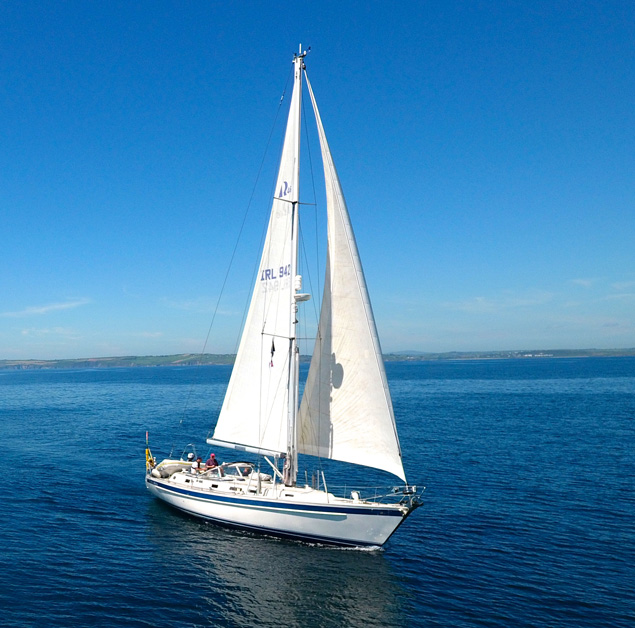 Time out. Jack and Rosemary Roy’s Hallberg Rassy 46 Tangaroa catches a few days of last month’s week of good weather with a short cruise off West Cork
Time out. Jack and Rosemary Roy’s Hallberg Rassy 46 Tangaroa catches a few days of last month’s week of good weather with a short cruise off West Cork
So although as the season eventually draws to a close in three months time we’ll hope to hear the views of the President on items which some people see as controversial, such as the clashing of major fixture dates and the development of Dun Laoghaire harbour’s sailing structure, for now we take inspiration from his joy in boats and sailing, and his seemingly infinite enthusiasm for putting so much back into a sport which continues to give him so much pleasure.
And though like many sailing folk he’d been vaguely hoping that this weekend might provide a bit of chillout time, we know that on this Saturday morning he’ll arrive aboard Tangaroa in Kinsale to give her a good clean-up to be ready for duties next week in Glandore, where he is in attendance at the Glandore Classic Regatta as President of Irish Sailing. That’s the way life is with Jack Roy.
Irish Sailing Shares The Love At SeaFest 2017
#TrySailing - Galway skippers, scouts, clubs and centres volunteered their time during SeaFest 2017 to give 555 children and adults a Try Sailing experience on Galway Bay.
Over 100 volunteers represented the likes of Galway Bay Tours, Galway Bay Sailing Club, Galway City Sailing Club, Galway Sea Scouts, Clifden Boat Club, Spiddal Sailing Club and na Badoiri na Claddagh.
Together they combined boats and manpower to give some of the 100,000-plus SeaFest visitors a chance to sail or motorboat, experience the power and history of the Galway Hooker, and in general share their love of sailing and the sea.
Try Sailing at SeaFest, in association with the Marine Institute, was part of Irish Sailing’s nationwide initiative to get more people involved in the sport without big money, a club membership or even needing to own a boat.
Try Sailing opportunities like crewing, training, open days, starter sessions and more are held throughout the year across the country. Visit www.trysailing.ie to find what’s closest to you.
A Summer of Sailing Ahead
This summer I’ll be wearing two hats – one as President of Irish Sailing, and the other as a Race Official at several events, and a very busy summer it is proving to be writes Jack Roy
It’s been a cracking season already producing much skill and exciting racing. The weather during May and early June had adverse effects, but despite some difficult conditions, both the Dun Laoghaire to Dingle and the ICRA National Championships at the RCYC produced great racing as well as a bit of that all important fun!
Last week Kinsale YC hosted the O’Leary Life Sovereign’s Cup where over 90 boats were treated to champagne sailing. Despite losing one day to the Irish summer, warm days, sunshine and sea breezes gave us three wonderful days of racing, at this most popular venue. Another exciting event came at the weekend with the inaugural Watersports Inclusion Games, which took place in Dun Laoghaire with over 80 volunteers providing activities for over 220 participants with various abilities on the physical, sensory, intellectual and learning difficulty spectrums and representing all ages, demographics and socio-economic backgrounds. The participants and their families had a chance to try sailing, rowing and canoeing, and it was a fantastic event showing how sailing really is a sport for all and a sport for life.
Still to come; this Friday (30th June) sees the start of Cork Dinghy Fest at the RCYC where over 100 dinghies will be in competition. Also taking place this weekend is the Marine Institute’s Seafest, the massive Galway port celebration of all our marine activities where Irish Sailing are providing water-based Try Sailing activities.
Heading even further west to the Aran Islands, where the WIORA West Coast Championships running from July 5th-8th, is being hosted by Seoltóireacht Árann, which we are happy to welcome as a Category 1 Irish Sailing Affiliated Club. Almost running concurrently from July 6th – 9th is the Volvo Dun Laoghaire Regatta, another big-ticket fixture in the calendar with 452 boats registered, 2,500 sailors expected and 35 classes represented. This is one of Ireland’s biggest sporting events in terms of numbers of competitors, and one that the whole of the Dun Laoghaire waterfront and town gets involved in.
July also sees a plethora of Class Nationals and Championships around the country, including the Optimists, National 18s, Mirrors, Toppers, RS, SB20s, Puppeteer, Howth 17s, Squibs, Mermaids, J24s, GP14s, 1720s, Flying Fifteens, Fireball, and the IMA Multihulls. And a parade of sail on July 23rd will mark the opening of Glandore Harbour Yacht Club’s week long Classic Regatta.
The Half-Ton Classics Cup taking place in August will attract 20 + boats, many from the Solent but with plenty of Irish interest too. Last year this event was held in Falmouth Yacht Club and this year it’s the turn of Kinsale YC to host these classic 1980s design, now beautifully refurbished boats. Also in August, some might say “the highlight of the summer” is Calves Week. Once again the relatively small Schull Harbour SC, with its large number of volunteers, will run this ever popular, fun based race week.
Apart from the support of the competitors, the common thread running through this calendar of fixtures is the ever-present volunteer base, without whom none of these events would take place. A sincere thank you to all and I wish everyone involved an enjoyable and safe summer on the water.
ISA’s Re-Brand as 'Irish Sailing' Gets Mixed Response
We live in a world swamped in acronyms, so much so that even a simple one like ISA has to be explained as “Irish Sailing Association” to all except those involved with or interested in our sport writes W M Nixon.
But we also live in a very crowded world where, if at all possible, the theme of “Less Is More” is increasingly desirable. So the announcement yesterday evening (Monday June 26th) by the Irish Sailing Association, that it is in the process of re-branding itself more simply as Irish Sailing, is in line with a distinct and generally desirable trend.
Like many who have been intimately involved with the ISA in its many manifestations, with it born out of the Irish Dinghy Racing Association and then mutating through the Irish Yachting Association to become the Irish Sailing Association, a first reaction was one of disapproval, but it changed.
There was something attractively personal about an Association, and as its constitution defines “sailing” as an “activity involving engine or sail-powered craft”, it was a recognizable coming-together of people with shared interests in a grouping with its own distinct identity under a very broad umbrella.
ISA provided a sense of belonging, and individual members could cherish their long personal links to it. Yet for outsiders – non-sailors who might be attracted into getting involved with some aspect of our diverse sport – the use of the acronym “ISA” and the defining word “Association” could be off-putting.
For longtime dedicated sailors, these might seem to be decidedly precious, nit-picking and very minor considerations. But you only get one chance to make a first impression, and the modern ideal is that the sense of something being a “movement” as much as an association is a significant factor in making a favourable first impression.
Then too, we’re trying to get away from acronyms, and reduce the number of syllables in a recognisable title to an absolute minimum. ISA as an acronym has only three syllables. But Irish Sailing Association arguably has seven syllables. This makes it quite a mouthful, thereby encouraging reversion to the acronym, which of itself tells us very little of what this organisation is all about
However, “Irish Sailing” has only four syllables. One more than “ISA” perhaps, but still few enough for people to gives it the full title when referring to it, rather than using the much-too-short and possible confusion-causing acronym IS.
So on balance, my response is that the re-branding as Irish Sailing deserves a guarded welcome. But I’m acutely aware that even though the announcement was made only last night, and on a very wet Monday night at that, heated passions are aroused, and there’s an equally tenable argument which sees it differently. That great contributor to Irish sailing afloat and ashore, Monica Schaefer of Greystones Sailing Club and the Wayfarer Class, speaks eloquently for those who feel a special personal link to our national authority:
“I find it incredible to think that the ISA is seriously going to change its name to the same initials/abbreviation as the worlds largest terror organisation. Surely someone must realise that using the initials I and S together will attract all sorts of problems with internet traffic, gaining attention from people not intent on enjoying sailing and from security systems designed to pick up internet / social media traffic that track that sort of thing.
How will racing sailors who are not part of a club now be identified on a race results sheet if they are no longer members of the ISA? Ah yes we can just put down IS instead of ISA, that’ll sort it - LOL
Notwithstanding the problems the initials might attract, surely removing the association makes the organisation so much more impersonal and commercial sounding, if it is no longer an association, does that mean that those who subscribe to it are simply customers and no longer members? Has anyone thought about the fact that If we are not members anymore we will soon lose our sense of belonging? I wonder if we are no longer members of an association will the new organisation be scrapping the membership fee in line with it’s new identity (lol again) presumable the ISA members can now expect a refund of their paid up fee for the remainder of this year.
On hearing this announcement today I immediately feel disconnected with the new identity. I have been a proud member of the ISA since the time of the IYA and now I feel that we the members have just been jettisoned over the side to make way for “progress”, and that we are no longer a part of this supposedly more marketable commercial organisation that has taken over.
Surely a name change requires discussion and debate with the membership and a vote at an AGM or EGM at least? It’s a huge identity change that effects us all so surely we should have a say in it.
This move shouts of commercial interest and does not I believe reflect the interest of the members, but maybe the organisation doesn’t need or want members anymore, and the commercial side of the business wants to follow the lead of ISAF who started this trend with their move from the easily recognised and meaningful ISAF branding to the dull and bland branding of World Sailing.
This really is a shock and not something that ISA members should take lightly.
Regards,
Monica Schaefer”
So Long, ISA - Hello, Irish Sailing
#IrishSailing - The Irish Sailing Association is now known as Irish Sailing.
The branding refresh comes on the foot of member feedback to Ireland’s national governing body for sailing, powerboating and windsurfing – and is intended to underline changes within the organisation as part of its five-year strategic plan.
The name change also echoes the ISAF’s switch to World Sailing in late 2015.
“Irish Sailing is more modern and welcoming, immediately understood by non-sailors and international audiences alike, and more appealing to those who might like to try our sports,” said the organisation in a statement.
As of yesterday (Monday 26 June), the new Irish Sailing logo appears on its website and social media feeds, and will gradually be rolled out across official documents, printed materials and products over the coming months.



























